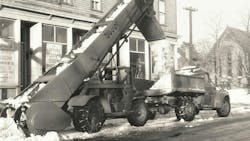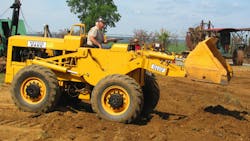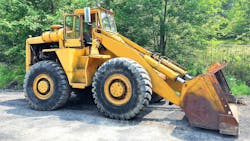Key Highlights
In this article, you'll learn:
- How Nelson Iron Works was founded.
- Its most innovative products.
- How it held up in a competitive market.
The N. P. Nelson Iron Works was established in Brooklyn, New York, in 1917 to fabricate machinery components for other manufacturers. In the early 1920s, Nelson moved to 850 Bloomfield Avenue in Clifton, New Jersey, where it would eventually grow to an 80,000-square-foot facility.
In 1923, Nelson launched an elevating snow loader that was mated to a Fordson tractor, one of numerous attachments and modifications that were offered for Fordson and other small wheel tractors in the 1920s and 1930s. Initially, the loader was attached to the tractor with minimal modification and driven by the tractor’s PTO. Steering and other controls were placed on the left side with a small platform for the operator. This enabled the machine to be driven backward into piles of snow more easily while loading into dump trucks.
Intense competition and lawsuits caused Fordson to leave the North American market in 1928, forcing Nelson to use another tractor; they chose International Harvester industrial tractors such as the I-20 and I-30 models. This development, along with emerging applications in excavation and stockpile loading, gave rise to a complex system of models. Various pairings of letters and numbers indicated combinations of power, mounting for mobility needs, loading equipment, size or weight, and specific applications.
In the mid-1930s, Nelson began building its own chassis with dual rear wheels or on tracks, and four-cylinder gas engines from Hercules (later LeRoi). Transmissions and controls were added from other makers, and the loaders could crowd while loading.
The early belt and bucket loaders were a cheaper, much more mobile and compact, and easier-to-transport alternative to power shovels. But the development of the wheel loader in the late 1940s and early 1950s drastically reduced sales of bucket loaders and forced Nelson to look for other products. In 1957, Nelson entered the wheel loader market, banking on the popularity of its bucket loaders with government customers; they are believed to be the only bucket loader manufacturer to have done this. Four models ranging from 1-5/8 to 4 cubic yards are known.
During the late 1960s, Nelson faced stiff competition against over a dozen other loader manufacturers, most offering more models with more advanced features including articulated frames and larger capacities. With no new models and lagging sales, Nelson shut down in the 1970s. The buildings, including offices and fabricating shops, have been converted to other businesses but still remain on Bloomfield Avenue.
About the HCEA
The Historical Construction Equipment Association (HCEA) is a 501(c )3 nonprofit organization dedicated to preserving the history of the construction, dredging and surface mining equipment industries. With over 3,500 members in a dozen countries, our activities include operation of National Construction Equipment Museum and archives in Bowling Green, Ohio; publication of a quarterly magazine, Equipment Echoes, from which this text is adapted, and hosting an annual working exhibition of restored construction equipment. Individual annual memberships are $45 within the U.S. and Canada, and $65 elsewhere. Our next International Convention and Old Equipment Exposition will be held August 28-30, 2026, at Concordia, Kansas. We seek to develop relationships in the equipment manufacturing industry, and we offer a college scholarship for engineering students. Information is available at www.hcea.net, or by calling 419.352.5616 or e-mailing [email protected].
About the Author
Tom Berry
Tom Berry is archivist for the Historical Construction Equipment Association (HCEA). Information is available at www.hcea. net, or by calling 419.352.5616 or e-mailing [email protected].



